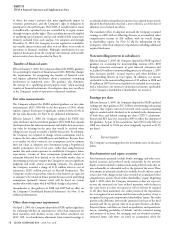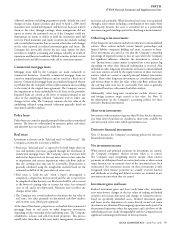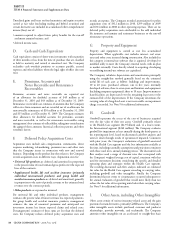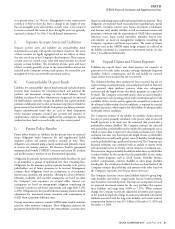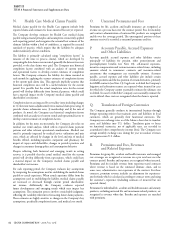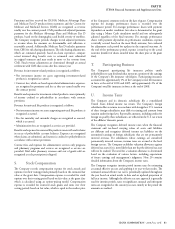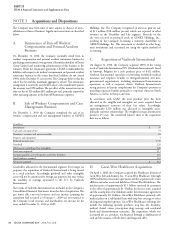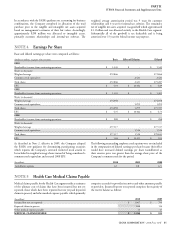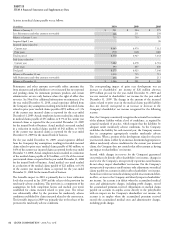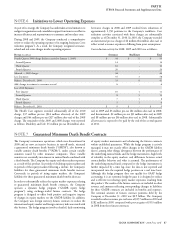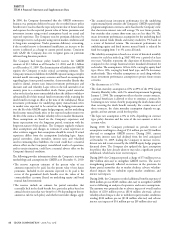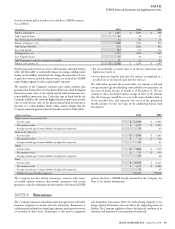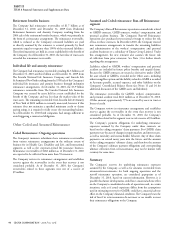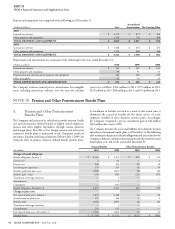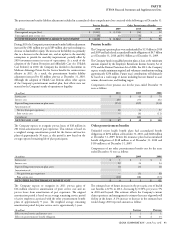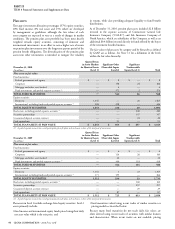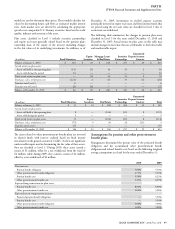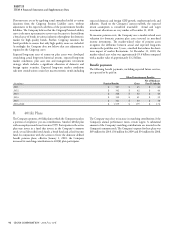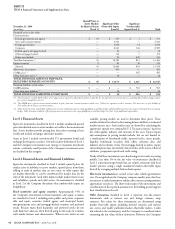Cigna 2010 Annual Report Download - page 108
Download and view the complete annual report
Please find page 108 of the 2010 Cigna annual report below. You can navigate through the pages in the report by either clicking on the pages listed below, or by using the keyword search tool below to find specific information within the annual report.CIGNA CORPORATION 2010 Form 10K
88
PART II
ITEM 8 Financial Statements and Supplementary Data
In 2000, the Company determined that the GMDB reinsurance
business was premium defi cient because the recorded future policy
benefi t reserve was less than the expected present value of future claims
and expenses less the expected present value of future premiums and
investment income using revised assumptions based on actual and
expected experience. e Company tests for premium defi ciency by
reviewing its reserve each quarter using current market conditions and
its long-term assumptions. Under premium defi ciency accounting,
if the recorded reserve is determined insuffi cient, an increase to the
reserve is refl ected as a charge to current period income. Consistent
with GAAP, the Company does not recognize gains on premium
defi cient long duration products.
e Company had future policy benefi t reserves for GMDB
contracts of $1.1 billion as of December 31, 2010, and $1.3 billion
as of December 31, 2009. e determination of liabilities for GMDB
requires the Company to make critical accounting estimates. e
Company estimates its liabilities for GMDB exposures using a complex
internal model run using many scenarios and based on assumptions
regarding lapse, future partial surrenders, claim mortality (deaths that
result in claims), interest rates (mean investment performance and
discount rate) and volatility. Lapse refers to the full surrender of an
annuity prior to a contractholder’s death. Future partial surrender
refers to the fact that most contractholders have the ability to withdraw
substantially all of their mutual fund investments while retaining the
death benefi t coverage in eff ect at the time of the withdrawal. Mean
investment performance for underlying equity mutual funds refers
to market rates expected to be earned on the hedging instruments
over the life of the GMDB equity hedge program, and for underlying
fi xed income mutual funds refers to the expected market return over
the life of the contracts. Market volatility refers to market fl uctuation.
ese assumptions are based on the Company’s experience and
future expectations over the long-term period, consistent with the
long-term nature of this product. e Company regularly evaluates
these assumptions and changes its estimates if actual experience or
other evidence suggests that assumptions should be revised. If actual
experience diff ers from the assumptions (including lapse, future
partial surrenders, claim mortality, interest rates and volatility)
used in estimating these liabilities, the result could have a material
adverse eff ect on the Company’s consolidated results of operations,
and in certain situations, could have a material adverse eff ect on the
Company’s fi nancial condition.
e following provides information about the Company’s reserving
methodology and assumptions for GMDB as of December 31, 2010:
• e reserves represent estimates of the present value of net
amounts expected to be paid, less the present value of net future
premiums. Included in net amounts expected to be paid is the
excess of the guaranteed death benefi ts over the values of the
contractholders’ accounts (based on underlying equity and bond
mutual fund investments).
• e reserves include an estimate for partial surrenders that
essentially lock in the death benefi t for a particular policy based on
annual election rates that vary from 0 to 15% depending on the net
amount at risk for each policy and whether surrender charges apply.
• e assumed mean investment performance for the underlying
equity mutual funds considers the Company’s GMDB equity hedge
program using futures contracts, and is based on the Company’s view
that short-term interest rates will average 5% over future periods,
but considers that current short-term rates are less than 5%. e
mean investment performance assumption for the underlying fi xed
income mutual funds (bonds and money market) is 5% based on
a review of historical returns. e investment performance for
underlying equity and fi xed income mutual funds is reduced by
fund fees ranging from 1 to 3% across all funds.
• e volatility assumption is based on a review of historical monthly
returns for each key index (e.g. S&P 500) over a period of at least
ten years. Volatility represents the dispersion of historical returns
compared to the average historical return (standard deviation) for
each index. e assumption is 16% to 26%, varying by equity fund
type; 4% to 10%, varying by bond fund type; and 2% for money
market funds. ese volatility assumptions are used along with the
mean investment performance assumption to project future return
scenarios.
• e discount rate is 5.75%.
• e claim mortality assumption is 65% to 89% of the 1994 Group
Annuity Mortality table, with 1% annual improvement beginning
January 1, 2000. e assumption refl ects that for certain contracts,
a spousal benefi ciary is allowed to elect to continue a contract by
becoming its new owner, thereby postponing the death claim rather
than receiving the death benefi t currently. For certain issuers of
these contracts, the claim mortality assumption depends on age,
gender, and net amount at risk for the policy.
• e lapse rate assumption is 0% to 24%, depending on contract
type, policy duration and the ratio of the net amount at risk to
account value.
During 2010, the Company performed its periodic review of
assumptions resulting in a charge of $52 million pre-tax ($34 million
after-tax) to strengthen GMDB reserves. During 2010, current
short-term interest rates had declined from the level anticipated
at December 31, 2009, leading the Company to increase reserves.
Interest rate risk is not covered by the GMDB equity hedge program
discussed above. e Company also updated the lapse assumption
for policies that have already taken or may take a signifi cant partial
withdrawal, which had a lesser reserve impact.
During 2009, the Company reported a charge of $73 million pre-tax
($47 million after-tax) to strengthen GMDB reserves. e reserve
strengthening primarily refl ected an increase in the provision for
future partial surrenders due to market declines, adverse volatility-
related impacts due to turbulent equity market conditions, and
interest rate impacts.
During 2008, the Company recorded additional benefi ts expenses of
$406 million pre-tax ($263 million after-tax) to strengthen GMDB
reserves following an analysis of experience and reserve assumptions.
e amounts were primarily due to adverse impacts of overall market
declines of $210 million pre-tax ($136 million after-tax), adverse
volatility-related impacts due to turbulent equity market conditions
totaling $182 million pre-tax ($118 million after-tax) and adverse
interest rate impacts of $14 million pre-tax ($9 million after-tax).


